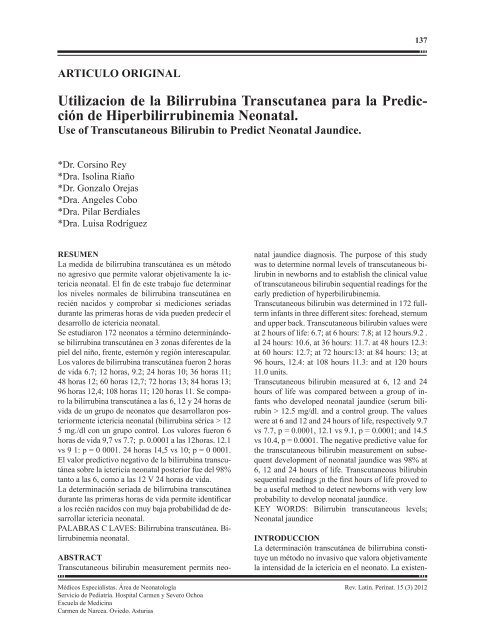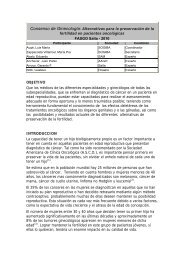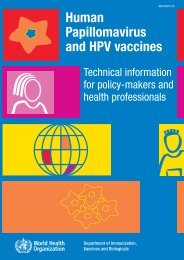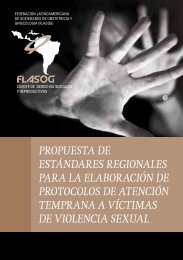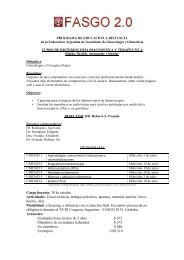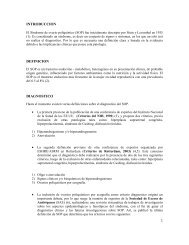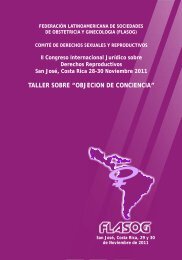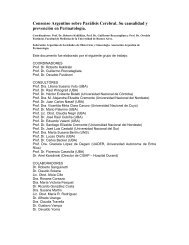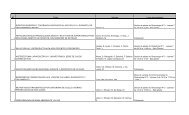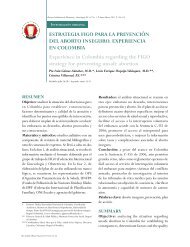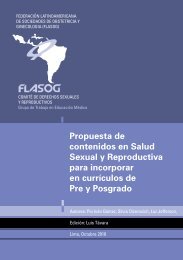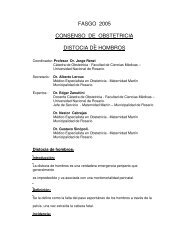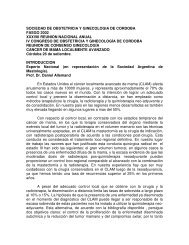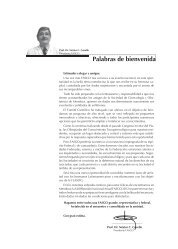Volumen 15 (3) de septiembre 2012 - fasgo
Volumen 15 (3) de septiembre 2012 - fasgo
Volumen 15 (3) de septiembre 2012 - fasgo
Create successful ePaper yourself
Turn your PDF publications into a flip-book with our unique Google optimized e-Paper software.
ARTICULO ORIGINAL<br />
Utilizacion <strong>de</strong> la Bilirrubina Transcutanea para la Predicción<br />
<strong>de</strong> Hiperbilirrubinemia Neonatal.<br />
Use of Transcutaneous Bilirubin to Predict Neonatal Jaundice.<br />
*Dr. Corsino Rey<br />
*Dra. Isolina Riaño<br />
*Dr. Gonzalo Orejas<br />
*Dra. Angeles Cobo<br />
*Dra. Pilar Berdiales<br />
*Dra. Luisa Rodríguez<br />
RESUMEN<br />
La medida <strong>de</strong> bilirrubina transcutánea es un método<br />
no agresivo que permite valorar objetivamente la ictericia<br />
neonatal. El fin <strong>de</strong> este trabajo fue <strong>de</strong>terminar<br />
los niveles normales <strong>de</strong> bilirrubina transcutánea en<br />
recién nacidos y comprobar si mediciones seriadas<br />
durante las primeras horas <strong>de</strong> vida pue<strong>de</strong>n pre<strong>de</strong>cir el<br />
<strong>de</strong>sarrollo <strong>de</strong> ictericia neonatal.<br />
Se estudiaron 172 neonatos a término <strong>de</strong>terminándose<br />
bilirrubina transcutánea en 3 zonas diferentes <strong>de</strong> la<br />
piel <strong>de</strong>l niño, frente, esternón y región interescapular.<br />
Los valores <strong>de</strong> bilirrubina transcutánea fueron 2 horas<br />
<strong>de</strong> vida 6.7; 12 horas, 9.2; 24 horas 10; 36 horas 11;<br />
48 horas 12; 60 horas 12,7; 72 horas 13; 84 horas 13;<br />
96 horas 12,4; 108 horas 11; 120 horas 11. Se comparo<br />
la bilirrubina transcutánea a las 6, 12 y 24 horas <strong>de</strong><br />
vida <strong>de</strong> un grupo <strong>de</strong> neonatos que <strong>de</strong>sarrollaron posteriormente<br />
ictericia neonatal (bilirrubina sérica > 12<br />
5 mg./dl con un grupo control. Los valores fueron 6<br />
horas <strong>de</strong> vida 9,7 vs 7.7; p. 0.0001 a las 12horas. 12.1<br />
vs 9 1: p = 0 0001. 24 horas 14,5 vs 10; p = 0 0001.<br />
El valor predictivo negativo <strong>de</strong> la bilirrubina transcutánea<br />
sobre la ictericia neonatal posterior fue <strong>de</strong>l 98%<br />
tanto a las 6, como a las 12 V 24 horas <strong>de</strong> vida.<br />
La <strong>de</strong>terminación seriada <strong>de</strong> bilirrubina transcutánea<br />
durante las primeras horas <strong>de</strong> vida permite i<strong>de</strong>ntificar<br />
a los recién nacidos con muy baja probabilidad <strong>de</strong> <strong>de</strong>sarrollar<br />
ictericia neonatal.<br />
PALABRAS C LAVES: Bilirrubina transcutánea. Bilirrubinemia<br />
neonatal.<br />
ABSTRACT<br />
Transcutaneous bilirubin measurement permits neo-<br />
Médicos Especialistas. Área <strong>de</strong> Neonatología<br />
Servicio <strong>de</strong> Pediatría. Hospital Carmen y Severo Ochoa<br />
Escuela <strong>de</strong> Medicina<br />
Carmen <strong>de</strong> Narcea. Oviedo. Asturias<br />
137<br />
natal jaundice diagnosis. The purpose of this study<br />
was to <strong>de</strong>termine normal levels of transcutaneous bilirubin<br />
in newborns and to establish the clinical value<br />
of transcutaneous bilirubin sequential readings for the<br />
early prediction of hyperbilirubinemia.<br />
Transcutaneous bilirubin was <strong>de</strong>termined in 172 fullterm<br />
infants in three different sites: forehead, sternum<br />
and upper back. Transcutaneous bilirubin values were<br />
at 2 hours of life: 6.7; at 6 hours: 7.8; at 12 hours.9.2 .<br />
aI 24 hours: 10.6, at 36 hours: 11.7. at 48 hours 12.3:<br />
at 60 hours: 12.7; at 72 hours:13: at 84 hours: 13; at<br />
96 hours, 12.4: at 108 hours 11.3: and at 120 hours<br />
11.0 units.<br />
Transcutaneous bilirubin measured at 6, 12 and 24<br />
hours of life was compared between a group of infants<br />
who <strong>de</strong>veloped neonatal jaundice (serum bilirubin<br />
> 12.5 mg/dl. and a control group. The values<br />
were at 6 and 12 and 24 hours of life, respectively 9.7<br />
vs 7.7, p = 0.0001, 12.1 vs 9.1, p = 0.0001; and 14.5<br />
vs 10.4, p = 0.0001. The negative predictive value for<br />
the transcutaneous bilirubin measurement on subsequent<br />
<strong>de</strong>velopment of neonatal jaundice was 98% at<br />
6, 12 and 24 hours of life. Transcutaneous bilirubin<br />
sequential readings ¡n the first hours of life proved to<br />
be a useful method to <strong>de</strong>tect newborns with very low<br />
probability to <strong>de</strong>velop neonatal jaundice.<br />
KEY WORDS: Bilirrubin transcutaneous levels;<br />
Neonatal jaundice<br />
INTRODUCCION<br />
La <strong>de</strong>terminación transcutánea <strong>de</strong> bilirrubina constituye<br />
un método no invasivo que valora objetivamente<br />
la intensidad <strong>de</strong> la ictericia en el neonato. La existen-<br />
Rev. Latin. Perinat. <strong>15</strong> (3) <strong>2012</strong>


